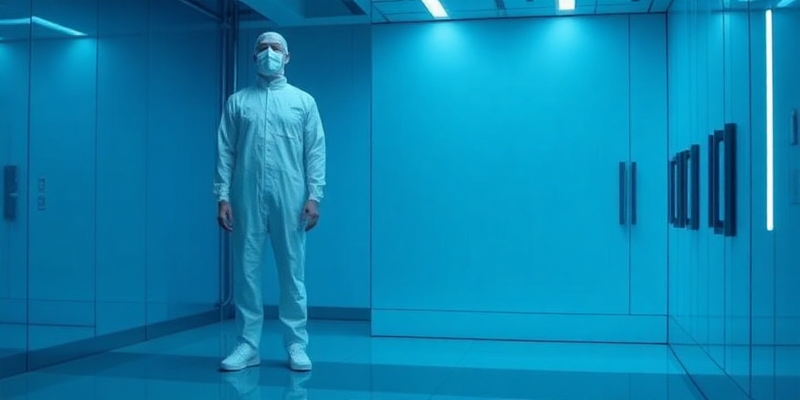Optimize Cleanroom Overalls for Linen Reuse & Dayanıklılık

Cleanroom overalls are essential for maintaining hygiene and safety in pharmaceutical manufacturing environments. However, color fading can hinder visual inspections and reduce linen reuse, posing significant challenges for textile service providers. This guide explores strategies to optimize cleanroom overalls for durability and sustainability, ensuring both compliance and cost-effectiveness.

The Impact of Color Fading on Cleanroom Overalls
Color fading in cleanroom overalls is more than just an aesthetic issue. It can have serious implications for pharmaceutical contractors and textile service providers:
- Compromised Visual Inspections: Faded overalls make it difficult to spot contaminants, potentially compromising product quality and safety.
- Reduced Linen Reuse: Garments that appear worn or faded are often discarded prematurely, even if they still meet cleanliness standards.
- Increased Costs: Frequent replacement of faded overalls leads to higher operational costs for both pharmaceutical companies and textile service providers.
- Environmental Impact: Premature disposal of serviceable garments contributes to textile waste and increases the industry’s environmental footprint.
To address these challenges, it’s crucial to implement strategies that maintain color integrity and extend the lifespan of cleanroom overalls.

Strategies to Prevent Color Fading
Textile service providers can employ several advanced techniques to minimize color fading and enhance the durability of cleanroom overalls:
- Advanced Textile Treatments:
- Dye-fixing agents: Apply treatments that bond dyes more securely to fabric fibers.
- UV-resistant finishes: Incorporate additives that protect against color degradation from light exposure.
- Optimized Washing Techniques:
- Low-temperature washing: Utilize specialized detergents designed for effective cleaning at lower temperatures.
- Gentle agitation: Implement washing cycles with reduced mechanical action to minimize fabric stress.
- pH-balanced solutions: Use cleaning agents that maintain a neutral pH to prevent color loss.
- Quality Control Measures:
- Regular color assessment: Implement spectrophotometric analysis to track color changes over time.
- Garment rotation: Establish systems to ensure even wear across the entire inventory.
By implementing these strategies, textile service providers can significantly extend the usable life of cleanroom overalls while maintaining their visual integrity for effective inspections.

Optimizing Linen Reuse in Cleanroom Environments
Effective linen reuse programs are essential for sustainable cleanroom operations. Here are key strategies to maximize reuse without compromising cleanliness or visual inspection standards:
- Implement a Robust Tracking System:
- Use RFID tags or barcode systems to monitor wash cycles and garment condition.
- Establish clear criteria for garment retirement based on both appearance and performance metrics.
- Enhance Garment Design:
- Incorporate reinforced areas in high-wear zones to extend overall garment life.
- Use modular designs that allow for partial replacement of worn components.
- Optimize Laundering Protocols:
- Develop customized laundering protocols based on specific cleanroom requirements and garment materials.
- Regularly validate washing processes to ensure consistent cleaning efficacy and minimal wear.
- Staff Training and Education:
- Train cleanroom personnel on proper garment handling and storage to minimize unnecessary wear.
- Educate staff on the importance of linen reuse for sustainability and cost-effectiveness.
Sustainable Solutions for Cleanroom Textiles
Case Study: Optimizing Cleanroom Overall Performance
Sıkça Sorulan Sorular
How does color fading affect cleanroom overalls?
Color fading can compromise visual inspections, making it difficult to identify contaminants. It also leads to premature garment retirement, increasing costs and environmental impact.
What are the best practices for linen reuse in cleanrooms?
Best practices include implementing robust tracking systems, optimizing laundering protocols, enhancing garment design for durability, and providing comprehensive staff training on proper garment care.
Which materials are most durable for cleanroom overalls?
High-quality polyester blends, especially those with recycled content, offer excellent durability. Advanced treatments and finishes can further enhance the longevity of these materials.
How can textile service providers reduce waste in cleanroom operations?
Providers can reduce waste by optimizing garment design for longevity, implementing effective linen reuse programs, adopting sustainable materials and processes, and partnering with recycling facilities for end-of-life garment management.
By focusing on durability, sustainability, and optimized processes, pharmaceutical contractors and textile service providers can significantly enhance the performance and lifespan of cleanroom overalls. This not only ensures compliance with stringent cleanliness standards but also contributes to more sustainable and cost-effective operations.
To learn more about how to optimize your cleanroom textile services and ensure your garments meet the highest standards of durability and performance, Request Laundering Validation Service today.









